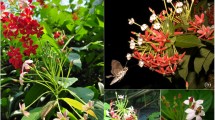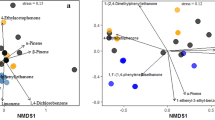Abstract
Floral odor is a key trait for pollinator attraction in many plants, but may also direct antagonists like herbivores to flowers. In this study, we examined how floral scent changes after pollination in Silene latifolia, which has a specialized relationship with the seed predator Hadena bicruris. We found an overall decrease in total scent emission and considerable changes in relative amounts of scent compounds after pollination. Lilac aldehydes A and B as well as veratrole contributed most to the decrease in scent emission. These three compounds are known to be key signals for the attraction of H. bicruris to the flowers. A specific downregulation of these compounds may increase the reproductive success of the plant by reducing seed predation after pollination.

Similar content being viewed by others
Explore related subjects
Discover the latest articles and news from researchers in related subjects, suggested using machine learning.References
Bopp, S. and Gottsberger, G. 2004. Importance of Silene latifolia ssp. alba and S. dioica (Caryophyllaceae) as host plants of the parasitic pollinator Hadena bicruris (Lepidoptera, Noctuidae). Oikos 105:221–228.
Dötterl, S. Jürgens, A. Seifert, K. Laube, T. Weissbecke, B., and Schütz, S. 2006. Nursery pollination by a moth in Silene latifolia: the role of odours in eliciting antennal and behavioural responses. New Phytol. 169:707–718.
Dötterl, S., Wolfe, L. M., and Jürgens, A. 2005. Qualitative and quantitative analyses of flower scent in Silene latifolia. Phytochemistry 66:203–213.
Dudareva, N., Murfitt, L. M., Mann, C. J., Gorenstein, N., Kolosova, N., Kish, C. M., Bonham, C., and Wood, K. 2000. Developmental regulation of methyl benzoate biosynthesis and emission in snapdragon flowers. Plant Cell 12:949–961.
Negre, F., Kish, C. M., Boatright, J., Underwood, B., Shibuya, K., Wagner, C., Clark, D. G., and Dudareva, N. 2003. Regulation of methylbenzoate emission after pollination in snapdragon and petunia flowers. Plant Cell 15:2992–3006.
Schiestl, F. P. and Ayasse, M. 2001. Post-pollination emission of a repellent compound in a sexually deceptive orchid: a new mechanism for maximising reproductive success? Oecologia 126:531–534.
Schiestl, F. P., Ayasse, M., Paulus, H. F., Erdmann, D., and Fancke, W. 1997. Variation of floral scent emission and postpollination changes in individual flowers of Ophrys sphegodes subsp. sphegodes. J. Chem. Ecol. 23:2881–2895.
Teis, N. and Raguso, R. A. 2005. The effect of pollination on floral fragrance in thistles. J. Chem. Ecol. 31:2581–2600.
Tollsten, L. 1993. A multivariate approach to postpollination changes in the floral scent of Platanthera bifolia (Orchidaceae). Nord. J. Bot. 13:495–499.
Tllsten, L. and Bergström, J. 1989. Variation and post-pollination changes in floral odors released by Platanthera bifolia (Orchidaceae). Nord. J. Bot. 9:359–362.
Acknowledgements
We thank Stefan Dötterl (Bayreuth) and Roman Kaiser (Dübendorf) for providing reference compounds used in this study. We are grateful to the reviewers who provided useful comments.
Author information
Authors and Affiliations
Corresponding author
Rights and permissions
About this article
Cite this article
Muhlemann, J.K., Waelti, M.O., Widmer, A. et al. Postpollination Changes in Floral Odor in Silene latifolia: Adaptive Mechanisms for Seed-Predator Avoidance?. J Chem Ecol 32, 1855–1860 (2006). https://doi.org/10.1007/s10886-006-9113-0
Received:
Revised:
Accepted:
Published:
Issue Date:
DOI: https://doi.org/10.1007/s10886-006-9113-0




